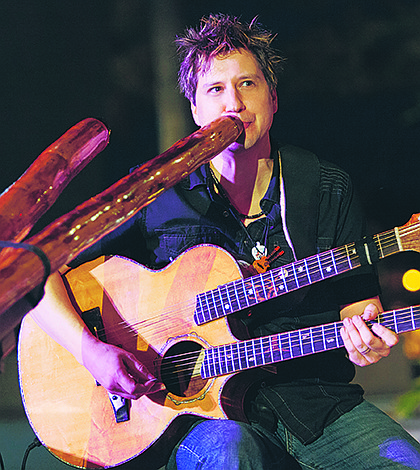- April 25, 2024
-
-
Loading

Loading

MusicFest is known for its abundance of engaging performers who cover a wide range of genres, but one local musician will be performing this year whose sound is distinctly diverse and natural. Dominic Gaudious, an Ocoee resident, was a guitarist for many years before discovering his next passion — the didgeridoo.
Now, he plays both simultaneously while using effects and loops to provide audience members the experience of hearing a full world-beat band. His MusicFest performance will be at 4:15 p.m. Saturday, Oct. 11.
The didgeridoo is a wind instrument developed by indigenous people of northern Australia, potentially as long as 1,500 years ago. It is described as a natural wooden trumpet or drone pipe. Authentic Aboriginal didgeridoos are made from hardwood — usually eucalyptus, which is endemic in the region.
To play the didgeridoo, musicians must be able to continuously vibrate their lips while vocalizing and using the technique of circular breathing, which requires simultaneous inhalation through the nose and exhalation from the mouth.
“You’re using your falsetto, mostly, and making cool little sounds — animal noises,” Gaudious said. “I think it’s one of the most therapeutic instruments that you can play.”
In the early 1990s, Gaudious, a rock musician, was living in Chicago and working as a broker for a health food company. One seemingly normal day at work, his musical direction changed forever.
A man walked into the office blowing into a plastic golf club tube. Gaudious asked what he was doing, and the man said he had made his own didgeridoo. Gaudious loved the sound and was inspired to make one for himself out of PVC pipe.
“I haven’t looked back since,” Gaudious said. “I was captivated by the sound of it. It’s got such an earthy, ethereal sound.”
Gaudious eventually upgraded to a more traditional instrument made of wood and worked his way to the ability to play didgeridoo and guitar simultaneously. This sound, inspired by both his rock background and Aboriginal traditions, became a niche that not many other musicians were filling in the United States.
In 1995, Gaudious quit his job and started touring the country, playing at colleges, bookstores, coffee shops and other venues.
“I just decided I wanted to do music, and I’ve only done music ever since,” he said.
His music has been featured on major national media such as NPR and Fox TV. He has also earned numerous awards and recorded 11 albums, including his most recent, “The Dominic Didgeridoo Express,” which earned the title of Best Funk CD in 2015 by the Akademia Music Awards.
But the most likely place that Central Floridians have seen Gaudious perform is in Disney Springs, where he plays from 7 to 11 p.m. Sundays through Wednesdays, in front of the Harley-Davidson store near Planet Hollywood.
“It’s been the most amazing gig ever — so much fun,” he said. “Every single night, people ask me … ‘What in the world is that thing?’”
Gaudious meets people from all over the world when he performs. Many are not familiar with the didgeridoo, but some are — particularly, tourists from Australia.
“Usually, people from Australia are polite and say that I do a good job combining the didgeridoo with the guitar, and my music is unique, and they enjoyed it,” Gaudious said.
Others occasionally tell him they don’t think he should be playing the instrument as someone who is not of Aboriginal descent.
“I apologize and say I mean no disrespect, and mention how much I love the instrument and learning about their culture,” Gaudious said.
Contact Catherine Sinclair at [email protected].
DIDGERIDOO DIY
Dominic Gaudious’ first didgeridoo was one he made on his own with materials easily found at any hardware store. Here’s a simple tutorial that you can follow to create yours.
MATERIALS
• One segment of 1.5-inch-diameter PVC pipe between 5 and 6 feet long. Shorter pipes will have a higher pitch; longer pipes will have a lower pitch.
• One 1.5-inch female-female coupler piece
• One bushing, either 1-inch or 1.5-inch wide. This is for the mouthpiece, so the diameter depends on your preference.
INSTRUCTIONS
• Clean the cut edges of the PVC pipe. Semi-attached fragments of plastic that remain after cutting could impede your airways. They can be shaved off with a pocketknife or similar tool.
• Assemble the instrument by placing the coupling firmly onto the end of the pipe and then fitting the bushing into the coupling.
Source: WikiHow